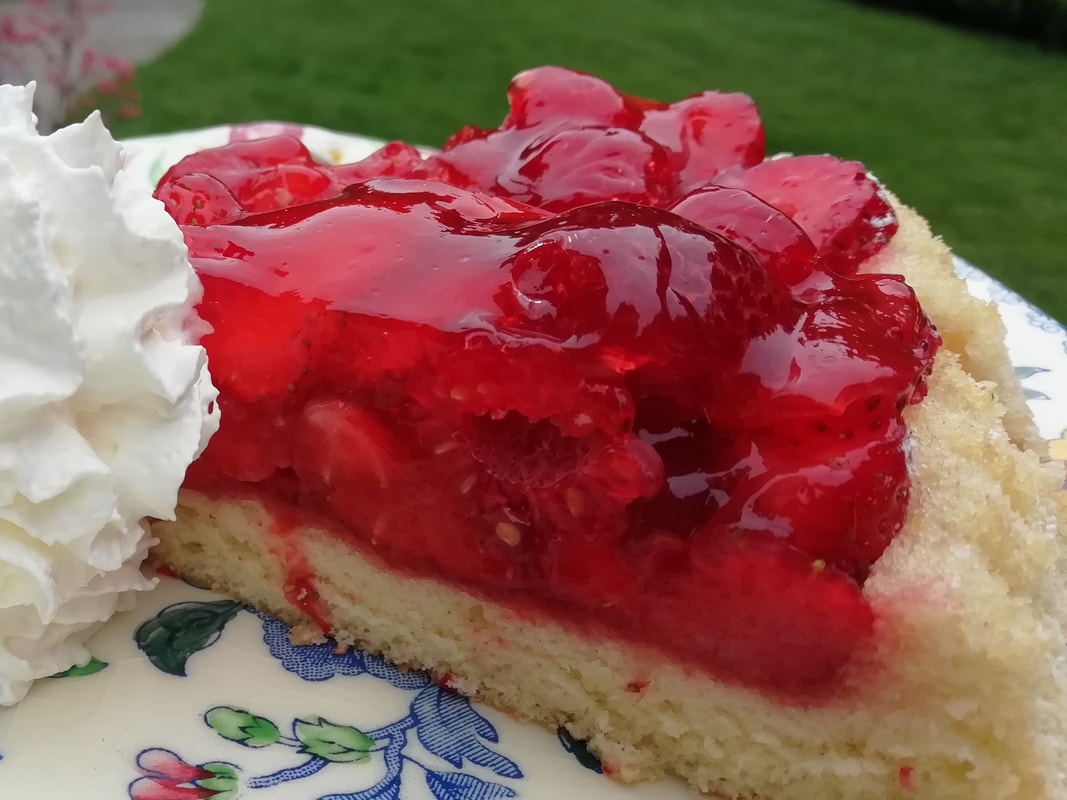|
Summer Fruit Sponge
Is it a flan? Is it a cake? It’s sort of both. This is another German recipe and it uses a jelly-like glaze on top of fresh fruit layered onto a sponge base. The glaze sticks the fruit together as well as giving it a nice shine and helping keep it fresh for a day. Unfortunately, it is not a cooking ingredient found in the baking supplies aisle of your local British supermarket, so you need to make it yourself or order it on-line – look for “tortenguss” which means “cake glaze”. I like the Dr. Oetker one, which is reliable and uses caragheen as a gelling agent, so it’s vegetarian. I wouldn’t ordinarily recommend an ingredient you can only get on-line but in this case I think it’s worth it. It comes in a set of 3 little sachets. You can buy a red-coloured version or a clear version – I like to use the red one for a flan like this with red berries and you would use the clear one for peaches or kiwi fruit. The base is a simple Genoese sponge (the One True Cake recipe). I used a special 28cm flan mould tin, which means the sides are slightly higher than the middle, so you can fill the middle with a mound of fruit. You can buy these sponge cases ready made but as you might expect, home made tastes best. You could make a simple round cake without the special mould tin, and it would be just as good. You top the cake with whatever soft fresh fruit is in season and can keep a day – so I wouldn’t use bananas or anything that might go brown or leak too much juice like a mango but an assortment of strawberries, raspberries, blackberries and blueberries tastes and looks wonderful. Yes, you can see some whipped cream from a can on the side of the cake in my photo. It’s a cheat but it’s the best way to provide whipped cream to my Lunch Group as I don’t like transporting containers of fresh whipped cream around in hot weather. My Seniors Lunch Group this week had a presentation from one of our members who is an enthusiast of military history. He told us all about D Day: the planning, the false trails laid for more likely invasion sites to distract the enemy, the use of floating harbours and the movement of troops on the day. It was fascinating and elicited memories from those who lived through World War II – we have a veteran in our group and many of the members were children or teenagers and remember those times very well. Then we discussed rationing and the difficulty many of the mothers had in providing tasty meals for their families on one egg and a scraping of butter per week. Lots of memories and lots of admiration both for those who went out and fought and those who stayed at home and made do. Serves 12 Timings: 90 minutes and then about 2 hours at least to set
Make the sponge. Preheat the oven to 180°C; and grease your cake tin thoroughly. Whisk the eggs and sugar together until fluffy while you melt the butter. Turn the motor lower and add in the flour and vanilla essence. Turn off the motor and pour the butter onto the mixture and stir through with a metal spoon. Spoon the mixture into the cake tin or flan tin and bake for about 15 minutes. Cool on a wire rack and turn the sponge carefully out of the tin. Leave to cool. When you’re ready to put the fruit onto the sponge, make sure you have the sponge on a cake base and on the dish you are going to use – once the jelly and fruit is on, you really can’t move it onto another plate as the sponge will be soaked with juice and very delicate. Prepare the fruit – hull the strawberries and cut into halves or slices. Clean the rest of the berries but don’t get them all wet, just wipe with a moist cloth. Make up the first packet of tortenguss - you can use water as the liquid or add a dash of fruit cordial to give an extra flavour. Allow it to cool a little then brush the whole jelly over the base of the sponge flan. This gives the first layer of jelly and seals the sponge a bit to protect it from the juice. Make up the next packet of tortenguss - now decorate your sponge base with all the fruit – make concentric rings of sliced strawberries first. Brush each layer of fruit with glaze as you go along, giving a nice shine to the berries. Top with whole raspberries, dot with blueberries or blackberries, whatever you have, and brush the top with glaze also. Put the cake into the fridge to set the glaze. It takes an hour or so in the fridge or a couple of hours in a cool place to set properly. It will keep overnight in a cool place but should be eaten no more than a day after making. Eat it with whipped cream and enjoy your summer Sunday afternoon.
0 Comments
Leave a Reply. |
Some Changes - April 2022
Thanks to my friends and followers for your patience, and for your encouragement to start blogging again. Archives
April 2022
Categories
All
|

 RSS Feed
RSS Feed
